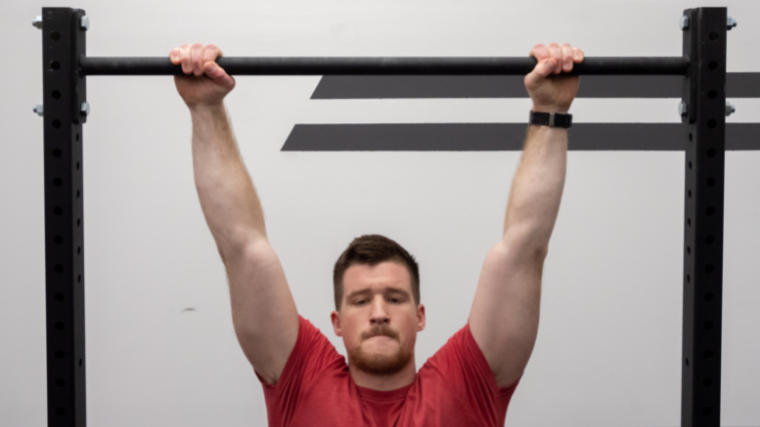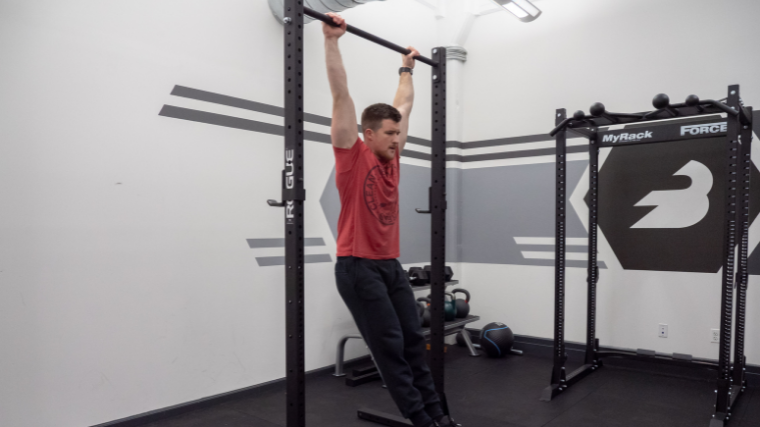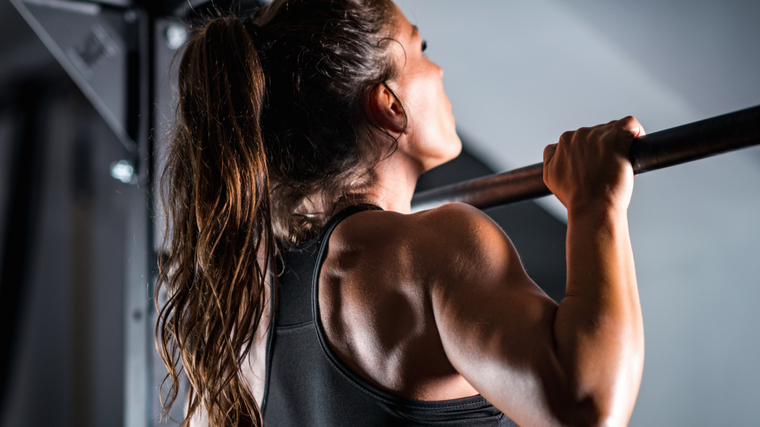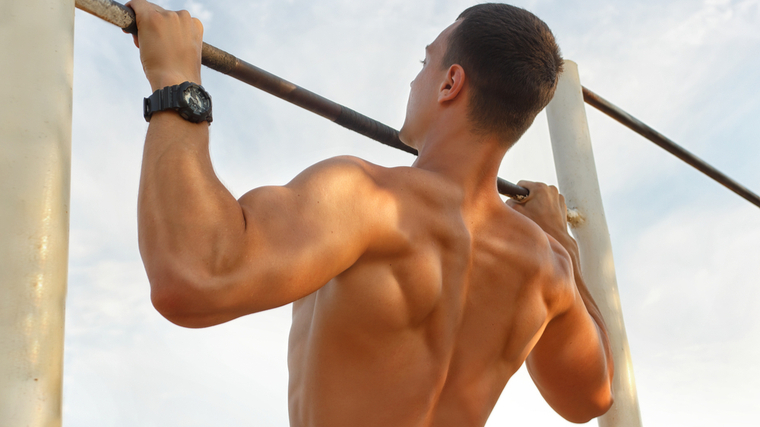Weighted pull-ups are a fantastic expression of full-body strength, coordination, and upper body stability. As a result, pull-ups are common fixtures in many well-rounded training routines. However, by adding weight to the movement, you can dial up the intensity and reap significantly more gains in strength and size.
In this article, we’ll overview the weighted pull-up and dive into details to help you better understand how to perform and progress.
- How to Perform the Weighted Pull-Up Step by Step
- Benefits of the Weighted Pull-Up
- Muscles Worked by Weighted Pull-Up
- Who Should Do the Weighted Pull-Up
- Weighted Pull-Up Sets, Reps, and Programming Recommendations
- Weighted Pull-Up Variations
- Weighted Pull-Up Alternatives
- Frequently Asked Questions
How to Perform the Weighted Pull-Up Step by Step
The weighted pull-up is primarily defined by its overhand grip position and, obviously, added weight. Therefore, we’re going to assume you have access to a weight belt, dumbbell, weighted vest some other external load. With that said, here’s a breakdown of the technique.
Step 1 — Get Your Grip
Hand placement will affect the amount of mechanical advantage your muscles will have during each repetition. To start, approach the bar and raise your arms directly above your head in a comfortable position. This should be a comfortable starting grip width.

Coach’s Tip: Additional grips can be tailored based upon your training progress and goal.
Step 2 — Set and Hang
Once you have selected your grip width, use a stable surface to assist grabbing the bar. Allow enough space for your body to hang freely once you have gripped the bar. Aggressively tense your grip on the bar while bracing your glutes and core for trunk stability.

Coach’s Tip: Jumping into position while performing weighted pull-ups is ill-advised as the weight belt and attached plate(s) may sway and contribute to loss of grip or stable body positioning.
Step 3 —– Pull With Purpose
Once full body tension has been established, your lats should be in an advantageous position to do most of the heavy lifting with some assistance from the biceps. Contract the lats hard while simultaneously pulling with the arms until you reach the top of the range of motion.

Coach’s Tip: Full range of motion typically means your chin has reached about even height with the bar.
Step 5 — Lower Under Control
Control of your descent during each repetition is crucial for maintaining proper technique. Keep tension locked in while you lower yourself in a controlled fashion back to the starting position. Otherwise, there is the risk that swaying of the body or attached weight will make stabilization and force production on subsequent repetitions unnecessarily difficult.
Coach’s Tip You can practice this step during unweighted pull-ups by adding eccentric tempo to your repetitions.
Benefits of the Weighted Pull-Up
Weighted pull-ups act as an expression of full body functionality. They contribute to overall strength and hypertrophy, but properly performing weighted pull-ups can also be seen as a method of proprioceptive development that benefits you far more than just growing the muscles involved.
Expression of Function
To successfully complete weighted pull-ups, many aspects of fitness must be present. There must be overall shoulder strength and stability, the ability to generate and hold full body tension, and, while most people view pull-ups primarily as a lat exercise, we cannot initiate a single weighted pull-up without a strong and healthy shoulder girdle.
When these boxes are checked, you can bet that there will be a ton of carryover to mainstay compound exercises and useful tools at your disposal as well.
Injury Risk Management
The weighted pull-up starting position allows you to take note of any substantial strength or mobility discrepancies at the shoulder. If left unchecked, discrepancies could predispose you to injury.
Counter to that, continuing to successfully load and progress weighted pull-ups keep your muscles and joints much safer during other exercises that may have high stability demands such as various pressing movements.
Balance and Control
As the weighted pull-up requires you to control external load in addition to your body weight as you manipulate yourself through space, it makes for a great way to practice your balance and body control. Good proprioceptive ability and spatial awareness can help you potentially stave off accidents in other skilled exercises as well.
Strength and Hypertrophy
Calisthenics are often underutilized in the development of strength and hypertrophy — and a weighted pull-up is a great mixture of both. The strength required to perform bodyweight pull-ups alone is significant, but when you add an external load, the additional challenge of neutralizing any unwanted movement requires substantial full body coordination and strength. As far as hypertrophy goes, progressing your weighted pull-up will add a healthy dose of muscle to your back, biceps, and shoulders.
Muscles Worked by the Weighted Pull-Up
A compound movement involves action at multiple joints. Naturally, this incurs plenty of muscular engagement as well — in the case of the weighted pull-up, the musculature of the back and arms do the proverbial, and literal, heavy lifting.

Lats
The prime movers of the weighted pull-up are the lats, or latissimus dorsi. The lats perform that bulk of the power output by retracting and depressing the shoulder, particularly in the first half of the movement.
Biceps & Forearms
Synergists of the weighted pull-up help the larger muscles in the back do their job, as well as help to finish off the range of motion towards the top. The notable synergists of the weighted pull-up include the forearms to provide adequate grip and the biceps, which help flex the elbow.
Rotator Cuff
Stabilizers are crucial for keeping the joints locked in so you can hit your reps properly under good control. In the case of the weighted pull-up, stabilizing muscles around the rotator cuff help provide a solid anchor for the lats and biceps.
Core
While you do get some core stimulation in a standard pull-up or chin-up, the added weight requires significantly more stability and effort by the abdominals to prevent swaying or shaking. Naturally, this added element of instability also provides a great stimulus for the abs.
Who Should Do the Weighted Pull-Up
The weighted pull-up is a progression of a calisthenic exercise and thus is an appropriate training tool for almost any training population. It can be the goal itself, or it can be a part of a larger training program designed to complement the adaptations necessary for full body strength and hypertrophy.
Physique Athletes
If you’re training for a bodybuilding show or just trying to add some mass to look good at the beach, weighted pull-ups can be a key element of your hypertrophy routine. The additional resistance takes a relatively low-load exercise and adds more than enough tension to spur new growth.
Strength Athletes
If you train for strength and power above all, the weighted-pull up can help you realize gains in your main lifts. A strong back is the bedrock of performance in powerlifting, Olympic lifting, and even strongman.
Regular Gymgoers
You don’t need a specific performance-related reason to add the weighted pull-up to your routine. It merits inclusion into any balanced exercise program simply for being a loadable, full-body compound movement that trains multiple qualities of fitness simultaneously. As a fun bonus, a good set of weighted pull-ups turns heads in the gym.
Weighted Pull-Up Sets, Reps, and Programming Recommendations
Whether it has earned a place as your main pulling movement or you’re using the weighted pull-up as an adjunct for other preferred strength and hypertrophy exercises (for example, barbell or machine work), keeping the loading light, progressive, and incremental at first is the best practice. That isn’t to say that the load stays light, but the integration and progression of weighted pull-ups should be strategic.
For Strength Gains
If you want to make the weighted pull-up your primary back movement for big strength gains, it abides by the same rules of strength gain as any other lift. However, you may have to modulate your loading parameters since adding weight to a calisthenic movement takes patience and persistence.
Start with three to four sets of five reps, adding weight in small increments of three to five pounds per week. Once you’re unable to add more weight regularly, try to perform more reps per set and then double back to restart your resistance progression.
For Muscle Growth
Safe, loadable, and multi-joint are the qualities that make the weighted pull-up an excellent hypertrophy exercise. When performing them for mass gains, prioritizing quality technique for higher reps to fully fatigue the muscles is the name of the game.
If you can do more than 12 bodyweight pull-ups, start with a very light weight and perform two to four weighted sets of roughly eight repetitions. Focus on working up to 12 or more quality reps before adding additional weight.
For General Fitness
If you simply want to use the weighted pull-up for general health or all-purpose performance, it makes the most sense to keep your muscles and joints safe and healthy by maintaining a conservative load progression. Slow and steady wins the race here.
Perform two to four sets of eight to 10 repetitions with the smallest load possible, especially if you’re just transitioning from unweighted to loaded pull-ups.
Weighted Pull-Up Variations
Variations of the weighted pull-up primarily come by way of different grip positions and grip widths. Be sure to select the right grip for your goals, as some choices modify overall muscle recruitment while others simply amplify the challenge of the pull-up itself.
Weighted Neutral-Grip Pull-Ups
Instead of grabbing the bar with a pronated (overhand) grip, position your hands using parallel bars to be neutral (palms facing each other). This alters the stability and force production demands of the exercise due to the orientation of the grip, allowing for greater mechanical advantage, making the reps a little easier.
Weighted Chin-Ups
Grip the bar with your palms supinated (underhand). Like neutral-grip pull-ups, this variation allows for greater muscle mass involvement of the arms as the orientation of the hand position helps to bias force production of the biceps to a greater extent than that of an overhand grip.
Wide-Grip Weighted Pull-Ups
Wide-grip weighted pull-ups increase the challenge of the exercise because the grip adjustment reduces the leverage of your muscles. The reduction in elbow flexion will apply more of the total load to the upper back, making this variation perfect if you’re looking for a real challenge.
Weighted Pull-Up Alternatives
If calisthenics aren’t your cup of tea or you don’t have access to an overhead bar, you can still bag some of the benefits of the weighted pull-up without ever performing one.
Unanchored Lat Pulldowns
Without hooking your legs in the lat pulldown station, you will be forced to produce as much full body tension as possible to move the load without having your body change positions. This is a great way to mimic the skill and body tension requirements you would find during weighted pull-ups.
Weighted Inverted Row
If you want to involve — and load — your body weight without being fully suspended in the air, the inverted row is a fantastic alternative. Many of the elements that define the weighted pull-up are still present here, including core stability, loadability, and compound stimulation. The inverted row is a little more beginner-friendly for those just getting started with back training.
Final Word
The pull-up is a “Swiss army knife” exercise. It can be molded and modified to fit almost any training goal or serve any purpose. Adding extra weight can help inspire new muscle growth, increase pulling strength, and supplement your other compound movements.
The extra core and stability work is the cherry on top that makes the weighted pull-up an extremely potent inclusion in your workout routine. If you want to get a lot out of a little, look no further.
Frequently Asked Questions
There’s a lot more to the weighted pull-up than you might notice at a glance. As such, having some lingering questions is perfectly normal. Addressing some common concerns should help you feel comfortable adding the weighted pull-up to your routine.
Are weighted pull-ups safe for beginners?
Frankly, it depends. Most rank beginners will have some difficulty performing standard body weight pull-ups at first. It isn’t wise to load up an already-challenging movement with extra weight. That said, if you’re proficient at pull-ups or chin-ups already, some light loading is just fine for a beginner.
Can I do weighted pull-ups every day?
One of the unique perks of calisthenics training is that it can be low-fatigue and low-impact, meaning you could do body weight exercises daily if you controlled for volume. However, adding additional resistance means adding more fatigue. As such, weighted pull-ups are probably not suitable for a daily exercise regimen.
When during my workout should I do weighted pull-ups?
While many routines and training plans typically put pull-ups at the end as a finisher or burnout exercise, added weight makes them applicable to any point in your routine. In fact, since they’re especially demanding on the body, consider performing your weighted pull-ups as your first main movement.
Featured Image: BLACKDAY/Shutterstock
The post How to Perform the Perfect Weighted Pull-Up appeared first on BarBend.
